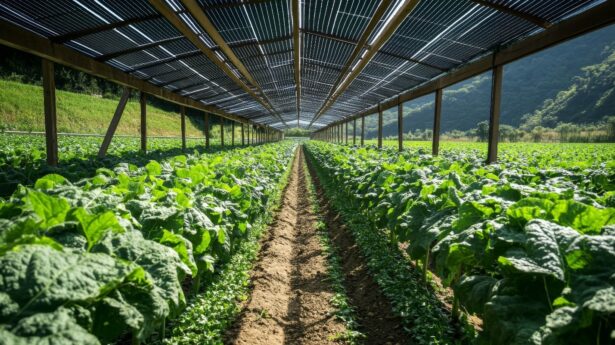Agriculture and energy production are two pillars of modern civilization, but they often compete for land, water, and resources. Stephen Wentzel explains that with the dual challenges of climate change and biodiversity loss, innovative solutions are needed to ensure that humanity can sustainably meet its food and energy needs while preserving the natural world. Enter agrivoltaics—a cutting-edge approach that combines solar energy production with sustainable agriculture practices to create a win-win for farmers, energy producers, and the environment.
Agrivoltaics, also known as agrisolar, involves the strategic installation of solar panels above agricultural land. Unlike traditional solar farms that occupy vast tracts of land and render them unsuitable for farming, agrivoltaic systems are designed to allow crops, livestock, or native vegetation to coexist beneath and around the panels. This dual-use model not only maximizes land efficiency but also enhances biodiversity and provides numerous ecological and economic benefits.
How Agrivoltaics Works
The core concept of agrivoltaics is simple: elevate solar panels to allow enough sunlight to pass through for plants to grow while capturing energy from the sun to generate electricity. The panels are often mounted on poles or structures high enough to accommodate farming machinery or livestock. Adjustable panels that track the sun’s movement or are designed with varying degrees of transparency can optimize light distribution for crops.
The shading created by solar panels offers a microclimate beneath them, where temperatures are cooler, evaporation rates are lower, and soil retains moisture more effectively. This creates ideal growing conditions for certain crops and offers protection against extreme weather, such as heatwaves or hailstorms.
Farmers can tailor agrivoltaic systems to suit their operations, whether they’re growing crops, raising livestock, or fostering pollinator habitats. Meanwhile, energy companies benefit from increased efficiency in land use, reduced resistance to solar installations, and new revenue-sharing models with agricultural partners.
Benefits of Agrivoltaics
- Improved Land Use Efficiency
Traditional solar farms and agriculture often vie for the same parcels of land, particularly in regions where arable land is limited. Agrivoltaics bridges this divide, allowing both energy and food production to thrive simultaneously. Studies have shown that combining the two can increase the total productivity of the land by as much as 60%.
- Enhanced Biodiversity
Agrivoltaics can be a boon for biodiversity, particularly when native plants and pollinator-friendly flowers are incorporated into the system. These habitats support bees, butterflies, and other insects crucial for pollination, benefiting nearby crops and ecosystems. Livestock grazing beneath solar panels can also reduce invasive plant species and promote the growth of native vegetation.
- Climate Resilience
Climate change poses significant risks to both agriculture and energy systems. Agrivoltaics offers resilience against these challenges. The shade provided by solar panels can mitigate the impacts of drought, reduce soil erosion, and create more stable conditions for crops. Additionally, renewable energy generated by agrivoltaic systems reduces greenhouse gas emissions, contributing to the fight against climate change.
- Economic Opportunities for Farmers
Agrivoltaics provides farmers with diversified income streams. By leasing land to solar developers or participating in energy co-ops, farmers can earn additional revenue while continuing agricultural activities. This financial boost can help small-scale farmers stay competitive in challenging economic conditions.
- Increased Energy Efficiency
The cooling effect of vegetation beneath solar panels can enhance the efficiency of solar energy production. When temperatures rise, solar panels become less efficient, but the cooler microclimate created by agrivoltaics can help mitigate this issue, leading to greater overall energy output.
Key Challenges
While agrivoltaics holds immense promise, it is not without its challenges.
- Initial Costs and Infrastructure
The upfront costs of installing agrivoltaic systems can be prohibitive for some farmers. Designing and constructing structures that balance solar and agricultural needs requires careful planning and significant investment. - Compatibility with Crop Types
Not all crops thrive in the partial shade created by solar panels. Agrivoltaic systems are better suited to shade-tolerant crops, such as leafy greens, herbs, and certain root vegetables. Research is ongoing to expand the range of compatible crops. - Policy and Regulation
Regulatory frameworks often fail to recognize dual-use land practices, creating barriers for agrivoltaic adoption. Governments and policymakers must update zoning laws, subsidies, and incentives to support this innovative approach. - Knowledge Gaps
Farmers and solar developers may lack the knowledge or experience to implement agrivoltaic systems effectively. Educational programs, demonstration projects, and research partnerships are critical to overcoming these barriers.
Real-World Applications
Agrivoltaics is already making an impact in regions around the globe.
- Germany: As a leader in renewable energy, Germany has piloted numerous agrivoltaic projects, focusing on crops like potatoes and wheat. These systems have demonstrated increased yields and lower irrigation needs.
- Japan: In Japan, agrivoltaics supports small-scale farmers who grow crops such as tea and rice while generating renewable energy for local communities.
- United States: States like Arizona and California are experimenting with agrivoltaic systems in vineyards, orchards, and arid regions where water conservation is critical.
- India: In India, agrivoltaics is being used to enhance agricultural productivity while addressing the country’s growing energy demands. Solar-powered irrigation systems have been particularly successful.
The Path Forward
Agrivoltaics represents a transformative opportunity to address the interconnected challenges of food security, energy production, and biodiversity loss. By embracing this innovative approach, we can create synergies between agriculture and renewable energy, paving the way for a more sustainable and resilient future.
Policymakers, researchers, and industry leaders must collaborate to scale up agrivoltaic systems, reduce barriers to adoption, and ensure that farmers receive the support and resources they need. With the right investments and incentives, agrivoltaics could play a central role in building a greener, more sustainable planet.
As humanity faces growing environmental pressures, solutions like agrivoltaics remind us that the answers to our most pressing challenges often lie in the harmony of nature and technology.
